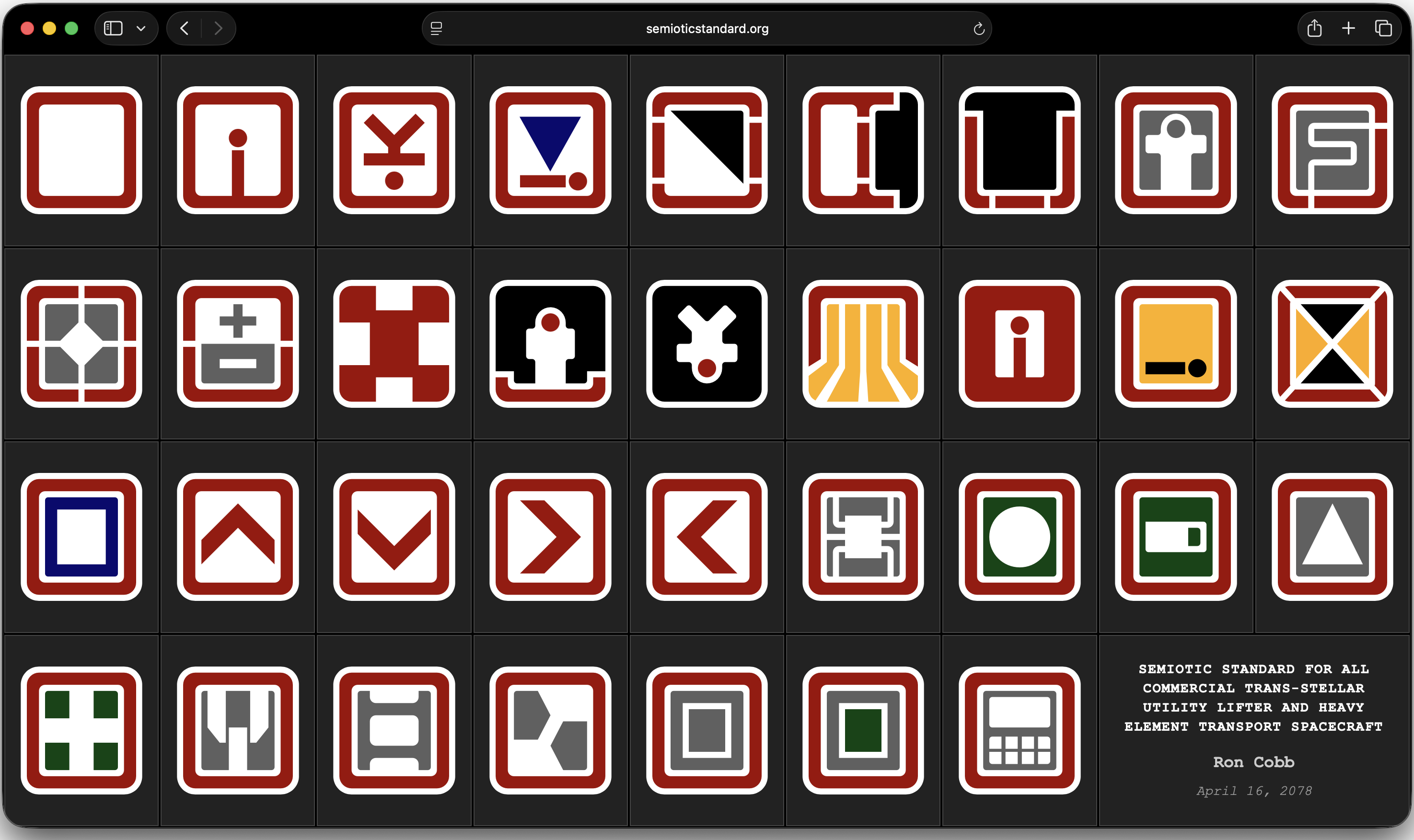Ron Cobb's iconic "Semiotic Standard" symbols for spacecraft, originally created for the 1979 science fiction film Alien.
- About the Semiotic Standard
- History and Cultural Impact
- Features
- Installation
- Usage
- Technical Details
- Contributing
- License
- Acknowledgments
The "Semiotic Standard For All Commercial Trans-Stellar Utility Lifter And Heavy Element Transport Spacecraft" is a comprehensive set of 30 standardized symbols designed by Ron Cobb in 1978. These symbols were created to provide a realistic, functional visual language for spacecraft interiors, representing various systems, hazards, and areas that would be found on commercial space vessels.
The standard includes symbols for:
- Environmental Systems: Pressurized areas, artificial gravity, airlocks
- Safety & Hazards: Radiation warnings, pressure suit requirements
- Life Support: Life support systems, galleys, medical facilities
- Navigation & Communication: Direction indicators, intercoms, computer terminals
- Storage & Maintenance: Storage areas, maintenance zones, ladderways
- Specialized Equipment: Lasers, photonic systems, refrigeration units
Ron Cobb developed the Semiotic Standard in 1978, predating its most famous appearance in Ridley Scott's 1979 film Alien. The symbols were designed with the future date of April 16, 2078, creating a sense of historical authenticity and forward-thinking design.
Cobb's approach was revolutionary for its time:
- Functional Realism: Each symbol was designed to be immediately recognizable and universally understood
- Systematic Approach: The symbols work together as a cohesive visual language
- Future-Forward Thinking: Designed for a future where space travel is commercial and routine
- Human-Centered Design: Prioritizing crew safety and operational efficiency
The Semiotic Standard has had a profound impact on:
- Science Fiction Design: Influencing countless films, games, and literature
- User Interface Design: Pioneering principles later adopted in real-world UI/UX design
- Visual Communication: Establishing standards for iconography in technical environments
- Popular Culture: Becoming instantly recognizable symbols of space exploration
This website provides:
- Interactive Symbol Gallery: Browse all 30 symbols from the Semiotic Standard
- Detailed Documentation: Learn about the history, purpose, and cultural impact of each symbol
- Responsive Design: Optimized viewing experience across all devices
- Educational Resource: Perfect for designers, science fiction enthusiasts, and design history students
- Vector Graphics: High-quality SVG symbols for crisp rendering at any size
This is a static website that can be run locally or deployed to any web server.
-
Clone the repository:
git clone https://github.com/banastas/SemioticStandard.org.git cd SemioticStandard.org -
Open the site in your browser:
open index.html
Or serve it with a local server:
python3 -m http.server 8000 # Visit http://localhost:8000
Deploy to any static hosting service:
- GitHub Pages: Already configured for deployment
- Netlify: Drag and drop the project folder
- Vercel: Connect your GitHub repository
- Any web server: Upload all files to your web root
Visit SemioticStandard.org to:
- Explore the complete set of 30 standardized spacecraft symbols
- Learn about Ron Cobb's design philosophy and process
- Understand the historical context and cultural impact
- Access high-quality vector versions of each symbol
- Study the systematic approach to visual communication design
- HTML5: Semantic markup and modern web standards
- CSS3: Custom styling with responsive design principles
- Vanilla JavaScript: Lightweight interactivity without dependencies
- SVG Graphics: Scalable vector graphics for symbol display
- Chrome (latest)
- Firefox (latest)
- Safari (latest)
- Edge (latest)
- Zero external dependencies
- Fast load times with optimized assets
- Mobile-first responsive design
- Accessible to screen readers and assistive technologies
Contributions are welcome! If you'd like to improve the documentation, fix bugs, or add features:
- Fork the repository
- Create a feature branch (
git checkout -b feature/improvement) - Commit your changes (
git commit -am 'Add new feature') - Push to the branch (
git push origin feature/improvement) - Open a Pull Request
Please ensure your contributions respect the educational and historical preservation nature of this project.
This project is licensed under the MIT License - see the LICENSE file for details.
The Semiotic Standard symbols themselves are the intellectual property of Ron Cobb and are used here for educational and historical preservation purposes.
- Ron Cobb (1937-2020): The visionary artist and designer who created the Semiotic Standard
- Ridley Scott: Director of Alien (1979), who brought the symbols to life on screen
- 20th Century Fox: For their support of innovative design in science fiction
- H.R. Giger: Swiss artist who collaborated with Cobb on Alien's visual design
- Dan O'Bannon: Screenwriter who worked with Cobb on the film's technical aspects
- The Alien Production Team: For integrating the Semiotic Standard into the film's universe
This project is a tribute to Ron Cobb's visionary work and the lasting impact of the Semiotic Standard on science fiction design and visual communication.
"The future is already here - it's just not evenly distributed." - William Gibson




